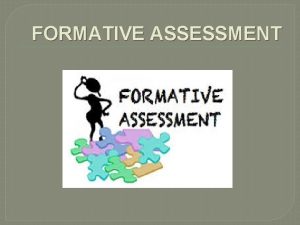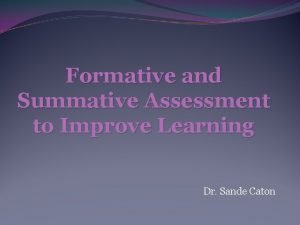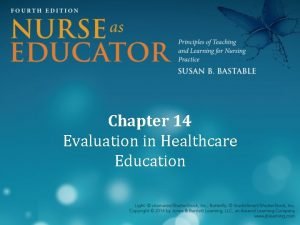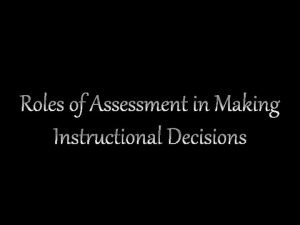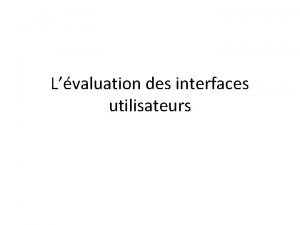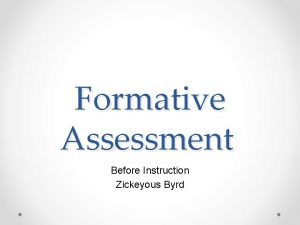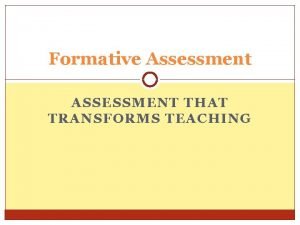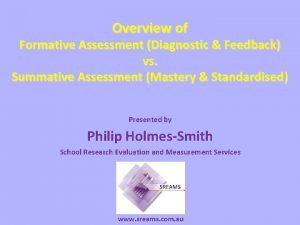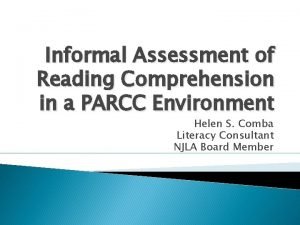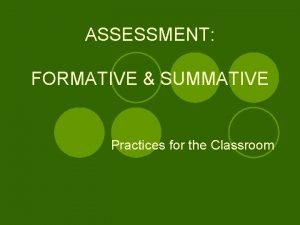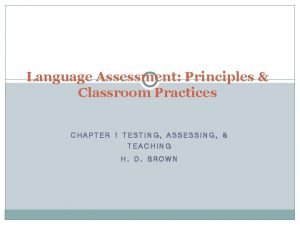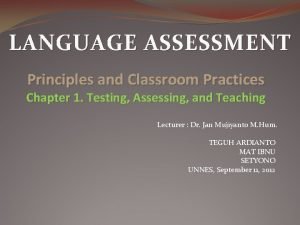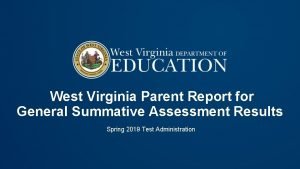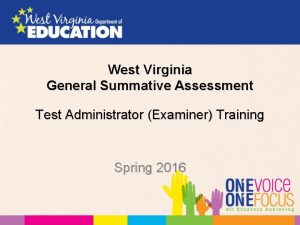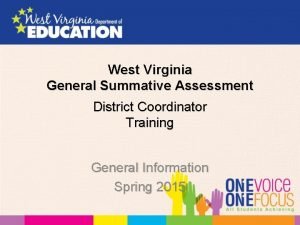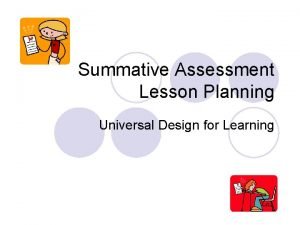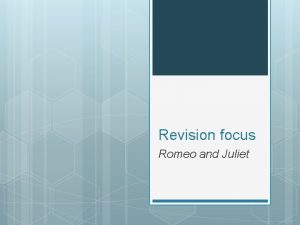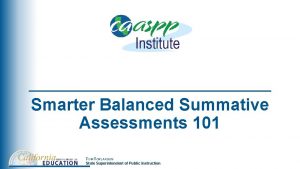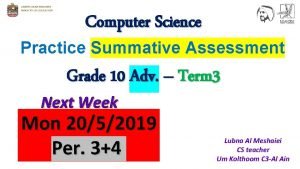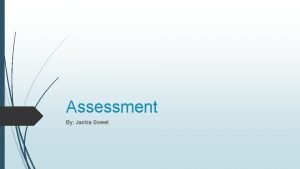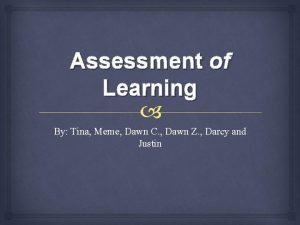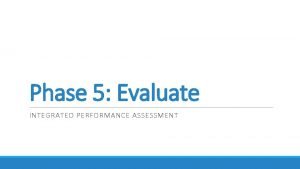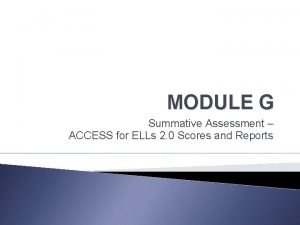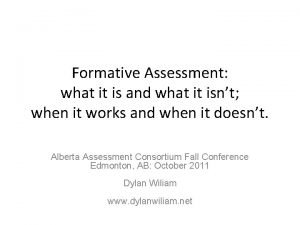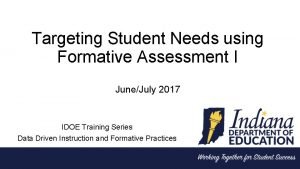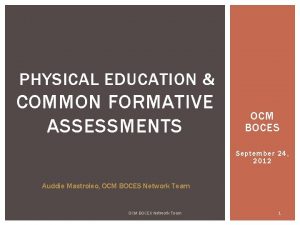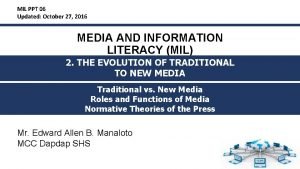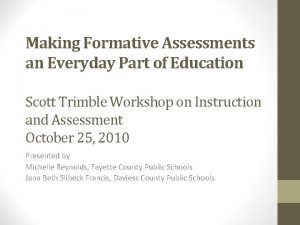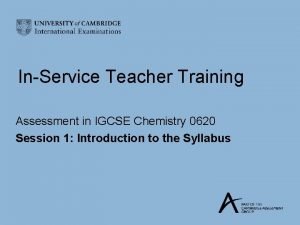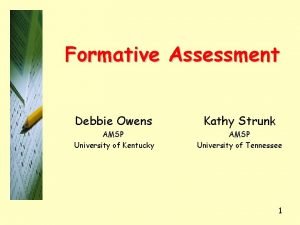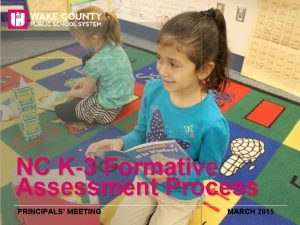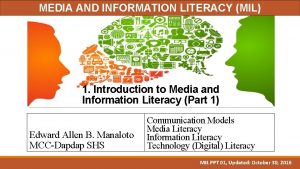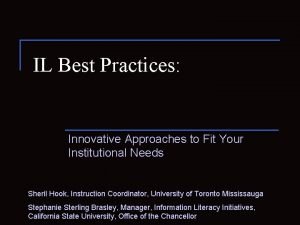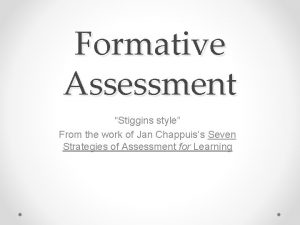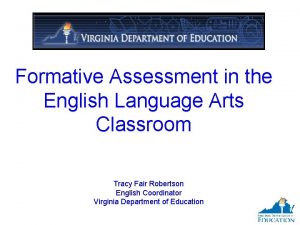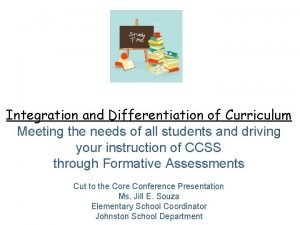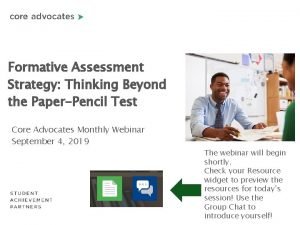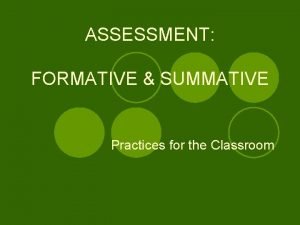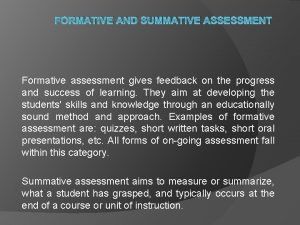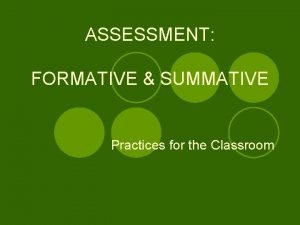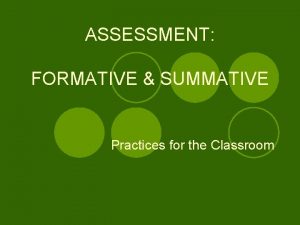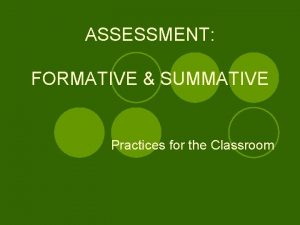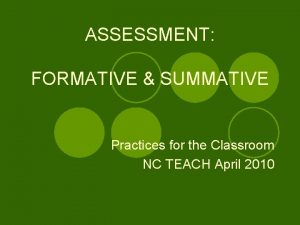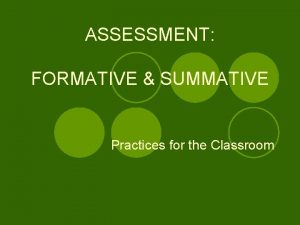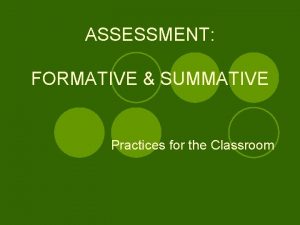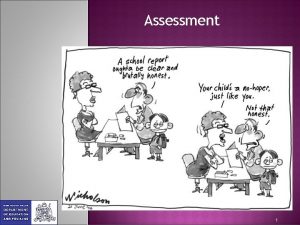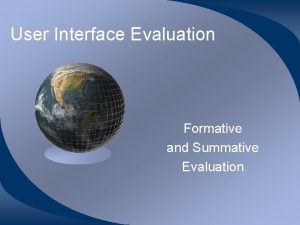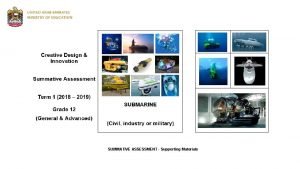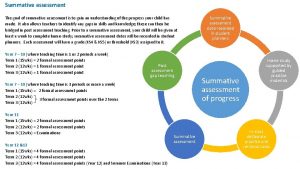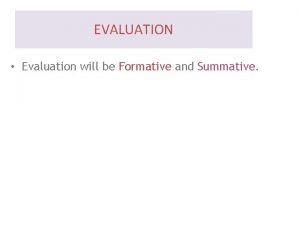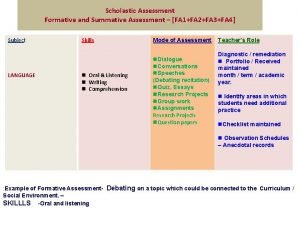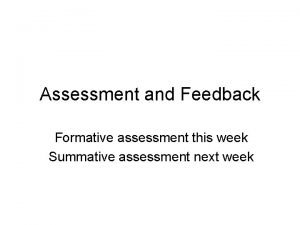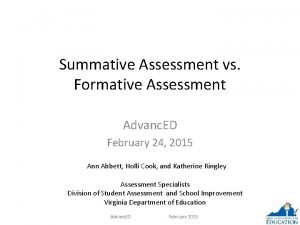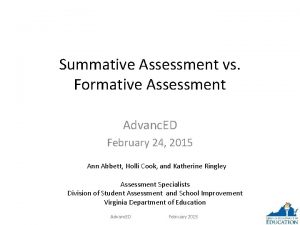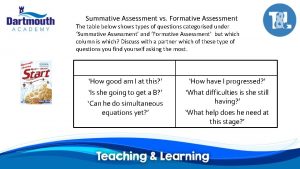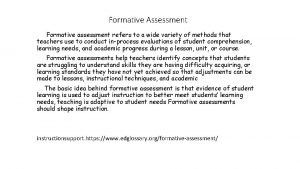ASSESSMENT FORMATIVE SUMMATIVE Practices for the Classroom NC










































- Slides: 42

ASSESSMENT: FORMATIVE & SUMMATIVE Practices for the Classroom NC TEACH April 2010

Think About It! Group Activity with Graphic Organizer l What is the difference between teaching and telling? l What is the difference between assessing and grading? l What is the difference between teaching and learning?


What is assessment? l Assessment for learning is best described as a process by which assessment information is used by teachers to adjust their teaching strategies, and by students to adjust their learning strategies. l Assessment, teaching and learning are inextricably linked, as each informs the others. l Assessment is a powerful process that can either optimize or inhibit learning, depending on how it’s applied.

Planned and Communicated l Assessment for learning should be built into teachers’ planning as a part of everyday classroom practice. l Learning goals, teaching strategies and assessment criteria should be carefully matched. Students should know in advance what they will learn, as well as how and why they are to be assessed. Teachers’ plans should be flexible so that they can make changes in response to new information, opportunities or insights.

Planned and Communicated l The planning needs to include strategies to check students’ understanding of the goals they are pursuing and the criteria that will be applied in assessing their work. l How students will receive feedback, how they will take part in assessing their learning and how they will be helped to make further progress should also be planned. l A teacher’s planning should provide opportunities for both student and teacher to obtain information about progress towards learning goals, and use it to direct the learning process.

Your Turn! l As you view the video, take notes on how the teacher gathers, interprets, and uses information to guide the learning of the students. l What was the objective? How does the teacher know if the students achieved it? l Assess the teacher’s behaviors in regards to the planning, execution, and monitoring of the lesson.

Why Discuss Assessment? ¡ A review of the data shows that there is a lot of testing happening in most districts, but that assessment does not necessarily drive curriculum and instruction. ¡ District educators indicated that the timeliness of receiving data impacts their ability to use it effectively. ¡ Educators expressed a frustration related to their ability to analyze and synthesize the data.

Assessment in education is the process of gathering, interpreting, recording, and using information about pupils’ responses to an educational task. (Harlen, Gipps, Broadfoot, Nuttal, 1992)

Individual Activity l Review the Anticipation Guide and respond to the statements or answer the questions. l Watch the video “Research Connections between Questioning/Learning”, and use the Anticipation Guide to answer any questions you didn’t know.

BALANCED CLASSROOM ASSESSMENT SYSTEM FORMATIVE ASSESSMENT SUMMATIVE ASSESSMENT A process used by teachers and students during instruction that provides feedback to adjust ongoing teaching and learning to help students improve their achievement of intended instructional outcomes. A tool used after instruction to measure student achievement which provides evidence of student competence or program effectiveness.

COMPARISON OF ASSESSMENTS FORMATIVE • Occurs During Instruction • Not Graded • Process • Descriptive Feedback • Continuous SUMMATIVE • Occurs at the end • Graded • Product • Evaluative Feedback • Periodic

Possible Assessment Methods Formative Assessment includes l l l l Questions Classroom Discussions Learning Activities Feedback Conferences Interviews Student Self-Assessment Summative Assessment l Selected Response ¡Multiple Choice ¡True/False ¡Matching ¡Fill-in l Extended Written Response l Performance Assessment

l. Formative and summative assessment are interconnected. They seldom stand alone in construction or effect. l. The vast majority of genuine formative assessment is informal, with interactive and timely feedback and response. l. It is widely and empirically argued that formative assessment has the greatest impact on learning and achievement.

Values and Attitudes about Assessment 1. 2. 3. 4. Teachers value and believe in students. Sharing learning goals with the students. Involving students in self-assessment. Providing feedback that helps students recognize their next steps and how to take them. 5. Being confident that every student can improve. 6. Providing students with examples of what we expect from them.

Formative Assessment l Assessment for learning l Taken at varying intervals throughout a course to provide information and feedback that will help improve ¡the quality of student learning ¡the quality of the course itself

l “…learner-centered, teacher-directed, mutually beneficial, formative, contextspecific, ongoing, and firmly rooted in good practice" (Angelo and Cross, 1993). l Provides information on what an individual student needs ¡To practice ¡To have re-taught ¡To learn next


Skittles Activity Objectives: Grade 7 l 1. 01 Develop and use ratios, proportions, and percents to solve problems. l 4. 01 Collect, organize, analyze, and display data to solve problems. Develop an assessment for one or both of the objectives using the Skittles.

Key Elements of Formative Assessment 1. The identification by teachers & learners of learning goals, intentions or outcomes and criteria for achieving these. 2. Rich conversations between teachers & students that continually build and go deeper. 3. The provision of effective, timely feedback to enable students to advance their learning. 4. The active involvement of students in their own learning. 5. Teachers responding to identified learning needs and strengths by modifying their teaching approach(es). Black & Wiliam, 1998

Summative Assessment l Assessment of learning l Generally taken by students at the end of a unit or semester to demonstrate the "sum" of what they have or have not learned. l Summative assessment methods are the most traditional way of evaluating student work. l "Good summative assessments--tests and other graded evaluations--must be demonstrably reliable, valid, and free of bias" (Angelo and Cross, 1993).

Formative Summative l‘… often means no more than that the assessment is carried out frequently and is planned at the same time as teaching. ’ (Black and Wiliam, 1999) l‘…assessment (that) has increasingly been used to sum up learning…’(Black and Wiliam, 1999) l‘… provides feedback which leads to students recognizing the (learning) gap and closing it … it is forward looking …’ (Harlen, 1998) l‘ … includes both feedback and self-monitoring. ’ (Sadler, 1989) l‘… is used essentially to feed back into the teaching and learning process. ’ (Tunstall and Gipps, 1996) l‘… looks at past achievements … adds procedures or tests to existing work. . . involves only marking and feedback grades to student … is separated from teaching … is carried out at intervals when achievement has to be summarized and reported. ’ (Harlen, 1998)

The Garden Analogy If we think of our children as plants … Summative assessment of the plants is the process of simply measuring them. It might be interesting to compare and analyze measurements but, in themselves, these do not affect the growth of the plants. Formative assessment, on the other hand, is the equivalent of feeding and watering the plants appropriate to their needs - directly affecting their growth.

Factors Inhibiting Assessment l A tendency for teachers to assess quantity and presentation of work rather than quality of learning. l Greater attention given to marking and grading, much of it tending to lower self esteem of students, rather than providing advice for improvement. l A strong emphasis on comparing students with each other, which demoralizes the less successful learners.

Self-evaluation Where would you place your assessment practice on the following continuum? The main focus is on: Quantity of work/Presentation Marking/Grading Comparing students Quality of learning Advice for improvement Identifying individual progress


Forms of Summative Assessment l Performance Assessment l Portfolio l Traditional Tests l NC End of Grade/End of Course Tests

NC End of Grade/End of Course Test l Go to www. ncpublicschools. org l Click on Testing, Scroll down and click on 20082009 Released Forms l Scroll down and click on the grade level and content area you would like to review. l Spend the next 20 - 30 minutes taking the test and checking your answers. l Grades k-2 - http: //www. ncpublicschools. org/ curriculum/mathematics/elementary/

Implications for classroom practice l Share learning goals with students. l Involve students in self-assessment. l Provide feedback that helps students recognize their next steps and how to take them. l Be confident that every student can improve.


Formative Assessment: Cooperative Learning l Think about the characteristics of formative assessment. l Does cooperative learning demonstrate any of these characteristics?

Cooperative/Collaborative Learning l Cooperative and collaborative learning differ from traditional teaching approaches because students work together rather than compete with each other individually. l Collaborative learning can take place any time students work together (individual and group accountability) l In a world where being a "team player" is often a key part of business success, cooperative learning is a very useful and relevant tool.

Cooperative/Collaborative Learning l Research suggests that cooperative and collaborative learning bring positive results such as deeper understanding of content, increased overall achievement in grades, improved selfesteem, and higher motivation to remain on task. Cooperative learning helps students become actively and constructively involved in content, to take ownership of their own learning, and to resolve group conflicts and improve teamwork skills.

Formative Assessment l Observing cooperative learning groups in action allows you to effectively assess students' work and understanding. Cooperative learning groups also offer a unique opportunity for feedback from peers and for self-reflection. l Research has shown that when implemented properly, students in cooperative learning classrooms outperform their peers in traditional classrooms.

Cooperative Structures l Fan-N-Pick ¡Played with higher-level thinking Q cards. #1 fans, #2 picks, #3 answers, #4 praises. Students then rotate roles.

Cooperative Structures l Numbered Heads Together ¡Students huddle to make sure all can respond, a number is called, the student with that number responds. l. Paired Heads Together: Students in pairs huddle to make sure they both can respond, an “A” or “B” is called, the student with that letter responds.

Cooperative Structures l Pass a Problem Review ¡Teams discuss topic written in the middle of the map, and then cover with sticky notes. ¡Teams record definitions, synonyms or antonyms, symbols, graphs, etc. to describe the topic or concept. ¡With the word covered, the charts are passed to another group to see if they can guess the word.

Cooperative Structures l Showdown ¡Teammates each write an answer, then there is a “showdown” as they show their answers to each other. Teammates verify answers.

Cooperative Structures l. Talking Chips ¡Students place their chip in the center each time they talk; they cannot speak again until all chips are in the center and collected.

Cooperative Structures l Think-Pair-Share ¡Students think about their response to a question, discuss answers in pairs, and then share their own or partner’s answer with the class. l. Think-Pair-Square: Same except students share their answers with teammates rather than with the class.

Assessment l How can you use cooperative learning activities to effectively assess your students?

Closure l How has the information shared today changed your views/thoughts about assessment? l What questions do you still have regarding assessment? l Do you feel confident that you can add the assessment (s) to your lesson plan to increase effectiveness and assist students in mastery of the intended objectives?
 évaluation formative
évaluation formative Summative
Summative Difference between formative and summative assessment
Difference between formative and summative assessment Formative diagnostic assessment
Formative diagnostic assessment Formative vs summative assessment
Formative vs summative assessment Formative vs. summative assessment venn diagram
Formative vs. summative assessment venn diagram Summative and formative assessment
Summative and formative assessment What is diagnostic assessment in teaching
What is diagnostic assessment in teaching Formative assessment
Formative assessment Formative vs summative
Formative vs summative Current issues in classroom testing
Current issues in classroom testing Summative evaluation
Summative evaluation Wv general summative assessment
Wv general summative assessment West virginia summative assessment
West virginia summative assessment Wvde secure browser
Wvde secure browser Summative assessment lesson plan
Summative assessment lesson plan Romeo and juliet summative assessment
Romeo and juliet summative assessment Objectives of summative evaluation
Objectives of summative evaluation Http://www.caaspp.org
Http://www.caaspp.org Summative assessment for the term 3 grade 10
Summative assessment for the term 3 grade 10 Sweet evaluation
Sweet evaluation Meme about assessment
Meme about assessment Ipa integrated performance assessment
Ipa integrated performance assessment Summative assessment
Summative assessment Diberikan suatu fungsi dengan persamaan y=2x-√x
Diberikan suatu fungsi dengan persamaan y=2x-√x Summative assessment
Summative assessment Formative assessment process
Formative assessment process Common formative assessment examples
Common formative assessment examples Formative assessment cartoon analysis
Formative assessment cartoon analysis Venn diagram of media information and technology literacy
Venn diagram of media information and technology literacy It refers to highly exposed and actively used media.
It refers to highly exposed and actively used media. Formative assessment kwl
Formative assessment kwl Facets of formative assessment
Facets of formative assessment Igcse teacher training
Igcse teacher training Round robin charts formative assessment
Round robin charts formative assessment Formative assessment cycle
Formative assessment cycle Formative assessment
Formative assessment Ritual or expressive model of communication
Ritual or expressive model of communication Formative assessment is tasting the soup while cooking
Formative assessment is tasting the soup while cooking Formative style
Formative style Formative assessment
Formative assessment Examples of formative assessment
Examples of formative assessment Examples of formative assessment
Examples of formative assessment
